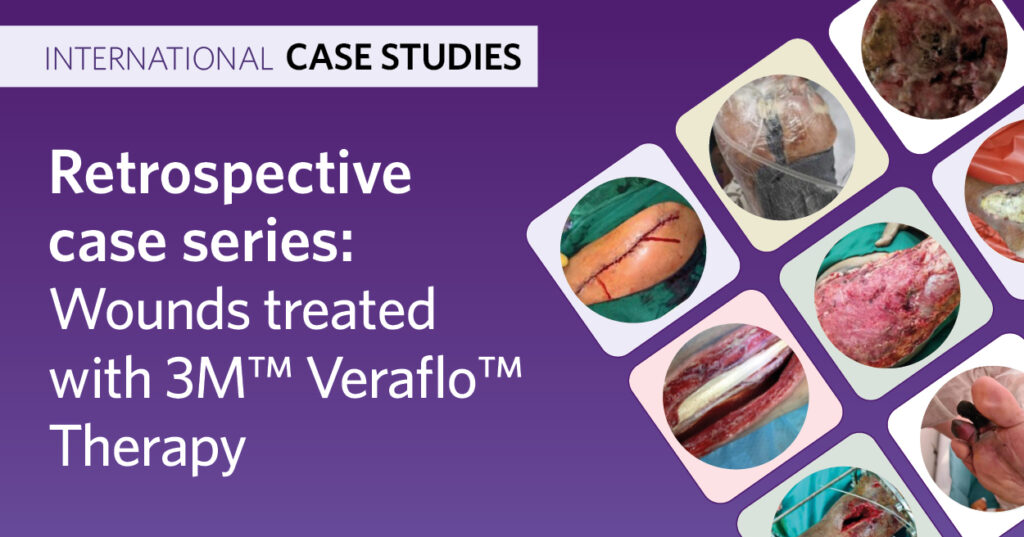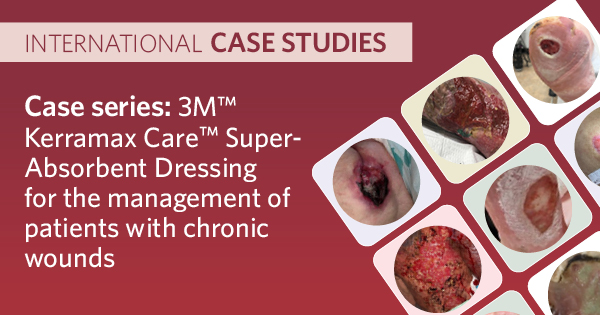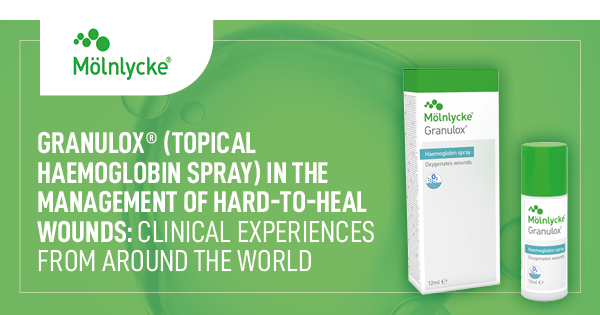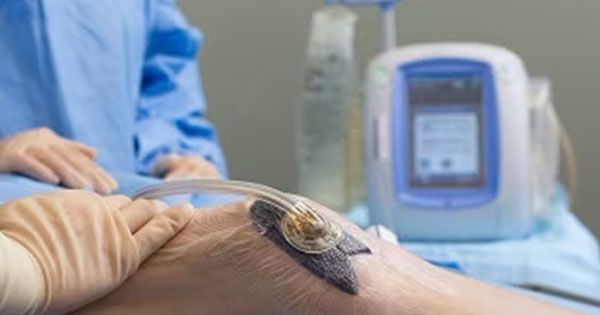Retrospective case series: Wounds treated with 3M™ Veraflo™ Therapy

3M™ Veraflo™ Therapy provides clinicians with a tool for managing patients and wounds with greater complexity [Box 1]. It combines the benefits of standard negative pressure wound therapy (NPWT; 3M™ V.A.C.® Therapy) with automated, user-determined delivery of topical wound treatment solutions that dwell in the wound to help dilute and solubilise infectious materials, slough and […]
Use of 3M™ Kerramax Care™ Gentle Border Super-Absorbent Dressing and 3M™ Kerramax Care™ Super-Absorbent Dressing for the management of four patients in the US with different chronic wounds

Chronic wounds, such as pressure injuries, diabetic foot ulcers, venous leg ulcers and other lower limb ulcers, impact an estimated 1–2% of people during their lifetime (Järbrink et al, 2016). Complications associated with wound chronicity [see Box 1; Järbrink et al, 2016] increase both the personal and financial cost of wounds in terms of impact […]
UrgoClean Ag and UrgoStart Plus in Real Life

The presence of wounds, more notably chronic wounds, represents a considerable burden in terms of economic cost to health and social care providers, and negatively impacts patient quality of life (Welsh, 2018). The growth in the incidence and prevalence of chronic wounds has been referred to as the modern age silent epidemic (Järbrink et al, […]
Surgical wound dehiscence (SWD): International consensus statement on assessment, diagnosis and management

The global volume of surgery is considerable and growing. It was estimated that 312.9 million surgical procedures were performed in 2012, which represented a 33.6% increase over 8 years (Weiser et al, 2015). Despite advances in surgical technique, intra-operative practice and the increasing availability of advanced wound dressings, surgical wound complications continue to pose significant […]
Incision care and dressing selection in surgical wounds: Findings from an international meeting of surgeons from Australia

Surgical wound complications, such as surgical site infection (SSI) and surgical wound dehiscence (SWD), are considerable worldwide healthcare concerns, which result in increased risk of morbidity and mortality (Allegranzi et al, 2011; Rickard et al, 2020; Sandy-Hodgetts et al, 2022a). Globally, the increase in antimicrobial resistance poses clinical challenges in the treatment and prevention of […]
Incision care and dressing selection in surgical wounds: Findings from an international meeting of surgeons from New Zealand

Surgical wound complications such as surgical site infection (SSI) and surgical wound dehiscence (SWD) are considerable worldwide healthcare concerns, which result in increased risk of morbidity and mortality (Allegranzi et al, 2011; Rickard et al, 2020; Sandy-Hodgetts et al, 2022a). Globally, the increase in antimicrobial resistance poses clinical challenges in the treatment and prevention of […]
Application of the M.O.I.S.T. concept to the healing of chronic wounds

M.O.I.S.T. (Moisture balance, Oxygen balance, Infection control, Supporting strategies and Tissue management) is an educational model that has been created to support healthcare practitioners in the systematic planning and delivery of topical treatment of chronic wounds. It extends beyond the principles of T.I.M.E. (Tissue management, Infection control, Moisture balance and Epithelial (or Edge) advancement; Schultz […]
Treatment with WOUND dressing spray based on St John’s wort oil and neem oil

The healing of acute wounds usually follows a fixed structured physiological pattern. This pattern consists of four different phases (haemostasis, inflammation, proliferation and remodelling). If this pattern is disturbed, the healing process is delayed and the wound may become chronic, which may result in ‘hard-to-heal’ or complex wounds (Sorg et al, 2017). Causes of delayed […]
Case series: 3M™ Kerramax Care™ Super-Absorbent Dressing for the management of patients with chronic wounds

EXUDATE MANAGEMENT AND THE ROLE OF 3M™ KERRAMAX CARE™ SUPER-ABSORBENT DRESSING Management of exudate is one of the biggest challenges in wound care. Highly exuding wounds can have a significant negative impact on quality of life as a result of (Browning, 2016; Hughes and Jones, 2017; World Union of Wound Healing Societies, 2019): It is […]
UrgoStart in Real Life

Chronic wounds are a challenge to clinicians involved in wound management and pose huge financial burdens on healthcare systems, while also having devastating effects on patients and their families.1 Chronic wounds are classified by aetiology, specifically, diabetic foot ulcers (DFUs), venous and arterial lower limb ulcers (LUs), and pressure injuries (PIs), as a consequence of […]
We must have a lot of noncompliant patients… or so I hear

I hear the term ‘noncompliant’ a lot and while there are better terms, such as nonadherent, to describe the patient who does not follow the prescriptions for care, I thought it might be worth examining why a patient would not ‘obey’, ‘comply’, ‘adhere’, etc. First off, the term, of even this concept, can never be […]
Top ten tips: realistic expectations about amputation

These 10 top tips will help guide you with the plan of care. 1 – Identify, assess and mitigate risk factors early The pathway to a diabetic foot ulcer and subsequent amputation is well-mapped, starting with neuropathy, ischaemia, infection and a preventable sentinel event in 86% of cases (Pecoraro et al, 1990). Prevention of amputation is […]
Top ten tips: medications that slow wound healing

We will organise the ten top tips into ten top medication classes and explain how each medication class works and how it impairs wound healing (Beitz 2017; Khalil et al, 2017). 1 – Anticoagulants are commonly used and alter early healing Examples: rivaroxaban and warfarin. Anticoagulants are frequently used to prevent development or worsening of […]
Generative artificial intelligence and ChatGPT as a chatbot for chronic oedema information

Digital health encompasses a vast array of electronic technologies and methods for improving healthcare delivery and outcomes. Some common forms of digital health communication are as follows. Electronic health records (EHRs), which are digital versions of patients’ medical records, including their medical history, diagnoses, medications, and test results. They can be used for large, population-based […]
Necrotising fasciitis and septic shock: a case report of a patient receiving an immunomodulatory agent for multiple sclerosis

Necrotising fasciitis (NF) is a soft tissue infection commonly caused by group A streptococcus (GAS) and is characterised by rapid progression and high mortality. It is considered one of the most dangerous infections in a surgical setting, as it remains silent for a long period and is diagnosed when it has already caused extensive local […]
Sequential wound management of chronic wounds with polyabsorbent fibre dressing coated with technology lipido-colloid and silver, and then with sucrose octasulfate dressing: a case series

Diabetes has been described as a ‘silent pandemic’, with the World Health Organization stating that 537 million people globally are living with diabetes in 2021 (Mnif et al, 2022). It is suggested that it is of a bigger concern in developing economies like India, mainly driven by the increasing prevalence of overweight and obesity, and […]
Clinical evaluation of UrgoClean Ag in patients with pressure injuries

Pressure injuries (PIs) are an unfortunate persistent problem in healthcare. PIs represent one of the most challenging clinical problems that negatively impacts patients’ lives emotionally, psychologically, physically and socially, and overall decreases their quality of life (Shiferaw et al 2020; Roussou et al, 2023) and their prognostic, while also increasing the workload and financial burden […]
Implementing the Wound Balance concept into routine practice worldwide

This publication represents the outcome of a meeting of international wound care experts held in Barcelona, Spain, in October 2023. In 2022, a document was published introducing the concept of Wound Balance: a multifactorial approach to achieving wound healing, encompassing scientific understanding, patient-centred care and clinical decision-making (Wounds International, 2023; figure 1). This current document […]
Wounds digest 15-2
In this section, we present brief synopses of a range of recently published articles that may be of interest to healthcare professionals working in the wound care setting. The aim of this round-up is to provide an overview, rather than a detailed summary and critique, of the research papers selected. Full references are provided should […]
Granulox® (topical haemoglobin spray) in the management of hard-to-heal wounds: Clinical experiences from around the world

Role of oxygen in wound healing The body’s first defence against microorganisms and trauma is the skin. When the skin is damaged, its natural protective barrier function is impeded. The tightly regulated biological process of wound healing is critical to the restoration of the skin’s barrier function (Han and Ceilley et al, 2017; Singh et […]
Quick Guide: Continuous Topical Oxygen Therapy (cTOT) for improved healing

The challenge The solution Introducing NATROX® O2 NATROX® O2 is a wearable medical device designed to deliver continuous topical oxygen therapy (cTOT) directly to a wound to support improved healing. Patients can continue with their normal daily activities as the device is: NATROX® O2 is an adjunct to standard of care (SoC), providing oxygen to […]
Continuous Topical Oxygen Therapy

Patients with a chronic wound may experience lack of oxygen (hypoxia) due to a variety of systemic disease states contributing to poor circulation (Cole and Woodmansey, 2023). Chronic hypoxia leads to inactivation of growth factors and cellular senescence, with eventual wound deterioration (Frykberg et al, 2023). Early intervention with supplemental oxygen, such as topical oxygen […]
You say “repositioning” andI say “turning”

Playing off the old saying “You say to-MAH-to and I say to-MAY-to”, I am a bit bewildered at what the words “repositioning” and “turn” mean — and what is actually done to move the bedridden patient. As student nurses, we were taught the hazards of immobility on all body systems. And when I first started […]
Top ten tips: putting medications in their place

This Ten Top Tips article will examine the frequently used medications in practice. 1 Normal saline Normal saline is currently being used to cleanse wounds between dressing changes. Normal saline is an ideal solution for keeping wounds moist, but does not kill pathogens. Additionally, it cannot mechanically disrupt any biofilm development unless used at high pressure. […]
Implementation of skin tone assessment in pressure ulcer prevention

Pressure ulcers are well known to be painful, costly and can negatively affect a patient’s quality of life. It has long been recognised that they increase the risk of infection, prolong hospital stays and can result in death (Young, 2021). Discrepancies and systemic biases have been identified across healthcare systems, meaning that patients with dark […]
Do peripheral arterial disease and smoking impede diabetic ulcer healing?

Diabetic foot ulcers are often refractory to medical and surgical therapies and responses to treatment likely depend on the stages of angiopathy and peripheral neuropathy (Coppelli et al, 2018). In the advanced stage of diabetes, angiopathy progresses to a pathological state termed “diabetic macroangiopathy”, which can lead to the development of peripheral arterial disease (PAD), […]
Negative pressure wound therapy with vancomycin wound instillation: a case report

Application of negative pressure wound therapy (NPWT) to an injured site is widely used to improve the healing of wounds, as described in Vikatmaa et al (2008). As several references have shown (Vikatmaa et al, 2008; Hasan et al, 2015), NPWT aids in the healing process by reducing oedema and encouraging new tissue formation, or […]
EGF in the treatment of electrical burns and the decrease of bone resorption

Electrical burns cause around 180,000 deaths a year and represent 5-8% of total burns in developed countries (World Health Organization, 2016). In adults, they occur during work activities; in children, they occur mainly at home. The injury severity depends on the intensity of the electrical current (determined by the source voltage and the resistance of […]
The use of transparent porous cellulose membrane in a surgical site infection in postoperative bicaval orthotopic heart transplant patient in Mexico: a case report

According to the CDC, surgical site infection (SSI) is defined as an infection related to a surgical procedure that occurs near the surgical site within 30 days after surgery (or up to 90 days after surgery when it comes to an implant). The overall incidence of infection in heart transplantation is 30-60%, with a mortality […]
Suitability of a transparent absorbent dressing to support surgical site infection surveillance

The enhanced recovery after surgery (ERAS) protocol is a standardised set of evidence-based, multimodal interventions and principles, designed to reduce the physiological stress of surgery and facilitate return to pre-operative levels of organ function. First described by Henrik Kehlet in 1997 in relation to colorectal surgery and initially named the “fast-track surgery” pathway (Kehlet, 1997), […]
Evaluation of a technology lipido-colloid non-adherent dressing with silver in the management of burn patients — a case series from India

A burn wound occurs when the skin comes into contact with a heat source, such as fire/flame, hot objects, electrical appliances and chemical agents. Injuries related to a burn are highly variable in their severity (Toussaint and Singer, 2014), where morbidity and mortality tend to increase in accordance with the surface area of the burn […]
Real-life experiences of a single-use, canister-based NPWT system

NPWT is one of a number of advanced interventions that clinicians consider when the use of passive dressings alone is deemed to be insufficient for the topical management of wounds. At the start of her presentation, Rosa Somma described NPWT as the topical application of negative (sub-atmospheric) pressure at the wound-dressing interface. Numerous NPWT systems […]
Wounds digest 15-1
In this section, we present brief synopses of a range of recently published articles that may be of interest to healthcare professionals working in the wound care setting. The aim of this round-up is to provide an overview, rather than a detailed summary and critique, of the research papers selected. Full references are provided should […]
Are incisions the forgotten wound? Rethink incision care to improve patient outcomes

It is generally accepted that a moist environment provides the optimal setting for wound healing, both in acute and chronic wounds. In recent years, a new concept has emerged in the field of surgical wound care: ‘undisturbed wound healing (UWH)’. This concept advocates allowing the healing process to progress uninterrupted, not disturbing the wound unless […]
Prontosan® Wound Irrigation Solution and Askina® Calgitrol® Paste in the treatment of diabetic foot ulcers

Effective management of bioburden in wounds is essential for successful wound healing. However, it is estimated that biofilm is present in 60–100% of non-healing wounds (World Union of Wound Healing Societies, 2016). Cleansing and removal of the biofilm is essential but can prove difficult in practice. Conventional cleansing products, such as saline, are ineffective against […]
Skin tears and skin tone

Defining skin tearsSkin tears are acute, traumatic wounds that have potential to develop into complex and chronic wounds, if not managed appropriately (Idensohn et al, 2019a). It has been shown that they are often under-recognised and under-reported in clinical settings (LeBlanc and Baranoski, 2017; Wounds UK, 2020), which can cause them to be misdiagnosed and […]
Buoying the spirits
In the mid 1500s, Gaspare Tagliacozzi was an Italian surgeon who designed a method to reconstruct the nose. He is considered a pioneer of plastic and reconstructive surgery for that work. But I like him best for his philosophy about the patients for whom he cared. Tagliacozzi said: “We restore, rebuild, and make whole those […]
Ten top tips: medications that slow wound healing

Medication effects range from very low risk to life-ending, so it is no surprise that some medications can have the same effect on wounds. Over the next three issues, the authors will be doing a deep dive on medications that impair and delay wound healing, medications that are thought to help wound healing but do […]
Paediatric acute compartment syndrome of the limbs due to fluid extravasation: a case study

Acute Compartment Syndrome (ACS) of the limbs is a severe condition caused by the increase of the pressure within an osteofascial compartment which is transmitted to the venous system causing further transudation of fluid leading to decrease of the perfusion gradient across capillary bed and subsequent cellular anoxia and muscle ischaemia (Seileret and Olvey, 2003; […]
Improved Bates-Jensen score following negative pressure wound therapy on wounds of various aetiologies: an experience from a tertiary care centre

Traumatic wounds are a loss in the integrity and continuity of the skin and causes serious tissue injury (Leaper, 2006). Wound healing and wound care are associated with huge medical costs. The total cost of wound care associated with acute and chronic wounds ranges between $28.1 billion to $96.8 billion (Nussbaum et al, 2018). Surgical […]
Assessment of chronic wound patients’ journey in India: a survey of the perspectives of healthcare professionals and patients

Chronic wounds fail to progress through a typical, orderly, and timely repair sequence due to the underlying aetiology (Bowers and Franco, 2020). Chronic wounds are complicated and are categorised as diabetic foot ulcers (DFUs), vascular ulcers (venous and arterial ulcers) and pressure injuries (Nunan et al, 2014; Frykberg and Banks, 2015). Chronic wounds share specific […]
sNPWT VivereX: Choosing single-use negative pressure wound therapy for hospital and home (international expert panel recommendation)

Introduced into clinical practice in the early 1990s, negative pressure wounds therapy (NPWT) has become a staple in both the inpatient and outpatient setting in the management of complex wounds (Bobkiewicz et al, 2014) [Box 1]. Historically, NPWT has been used to manage different acute and chronic wounds, for example, open fasciotomy wounds and diabetic […]
An unexpected infection in a venous leg ulcer: a case report

Providencia rettgeri is a Gram-negative bacillus that belongs to the Enterobacteriaceae family. It is commonly considered as a commensal microorganism which colonises the human gastrointestinal tract and is ubiquitous in soils, water and animal reservoirs (Washington et al, 2015; Huff and Blome-Eberwein, 2022). There are currently five species in the genus Providencia: P rettgeri, P […]
Conference Report: LINK for Wound Balance Congress 2023

The Wound Balance plenary session opened with Dr Alison Garten who presented the Wound Balance concept (Wounds International, 2023; Figure 1). She described the three main components of Wound Balance and how implementation of the concept in her daily practice helps drive appropriate wound care, to ultimately improve the patient’s quality of life (QoL) and […]
Using laboratory and clinical data to inform best practice in the delivery of negative pressure wound therapy

While dressings play a key role in the management of open wounds and closed surgical incision sites, more specialised interventions are often required; for example, when exudate levels are high or patients are considered to be at high risk for wound complications. One such intervention is negative pressure wound therapy (NPWT) which, in simple terms, […]
Wounds digest 14-4
In this section, we present brief synopses of a range of recently published articles that may be of interest to healthcare professionals working in the wound care setting. The aim of this round-up is to provide an overview, rather than a detailed summary and critique, of the research papers selected. Full references are provided should […]
The often-ignored importance of the lymphatics of the foot and legs: the sole of the lymphatic system!

Da Vinci famously said: “The human foot is a masterpiece of engineering and a work of art.” With each foot containing 26 bones, four layers of intrinsic muscles, intricate neurological and vascular network and complex biomechanics, it is not difficult to see why this statement was made. But what about the frequently overlooked and underestimated […]
Resistance training in patients with secondary lymphoedema: does it have any effect on functional and quality of life measures?

Lymphoedema is a chronic lymphatic disease that results in an abnormal accumulation of protein-rich fluid in the interstitial space in one or more parts of the body that have damaged nearby lymph nodes or vessels (Lyons and Modarai, 2019). It can cause pain, discomfort, heaviness, tightness, distortion and reduced mobility and function of the affected […]
Complex decongestive physiotherapy in paediatric patients with precox primary lymphoedema

Primary lymphoedema results from congenital lymphatic damage that requires lifelong management of symptoms (e.g. swelling, pain, heaviness). The accumulation of protein-rich fluid in the subcutaneous tissue as a result of the failure of the lymphatic system, which returns water and protein in the interstitial spaces to the blood circulation, is called lymphoedema (LO; Sander et […]
The use of eHealth and digital health technology for lymphoedema care

The World Health Organization (WHO, 2023) defines eHealth as: “The cost-effective and secure use of information and communications technologies in support of health and health-related fields, including health-care services, health surveillance, health literature, and health education, knowledge and research.” eHealth encompasses a wide range of modalities that utilise digital technology, including robotics, artificial intelligence, wearable […]


